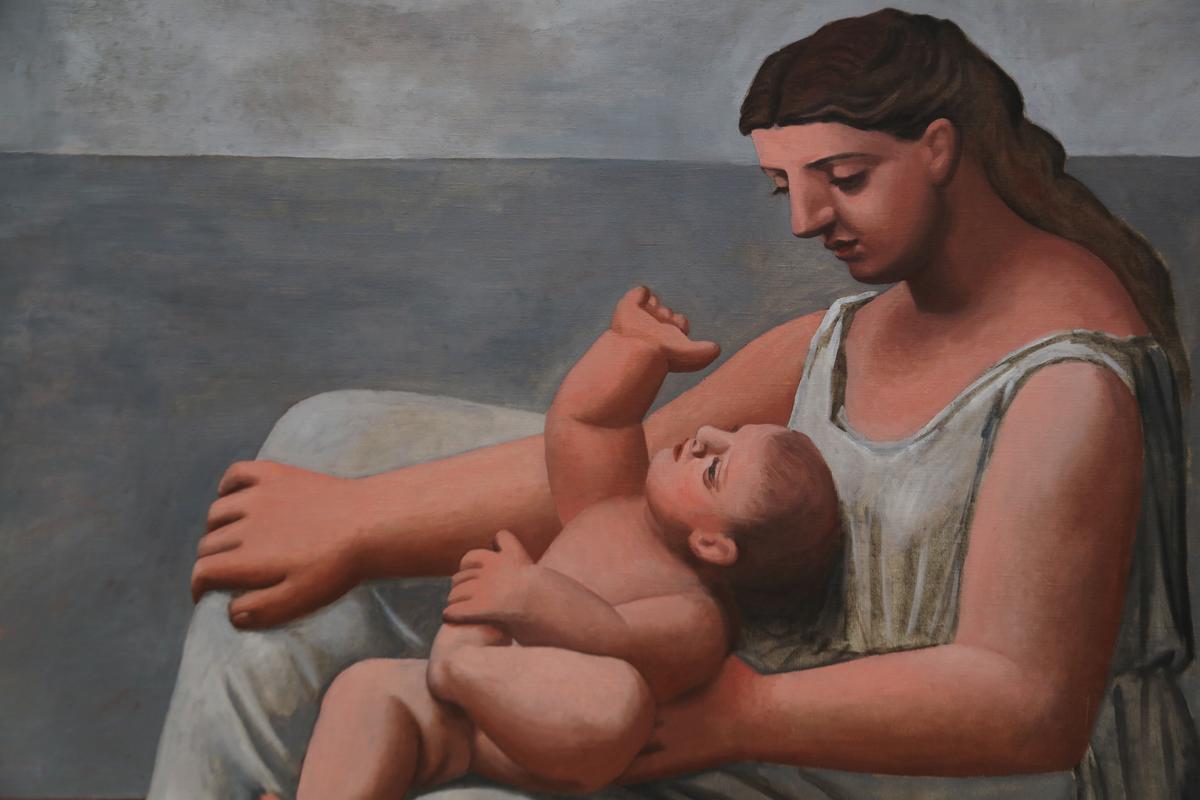More about Mother and Child

Sr. Contributor
In stark contrast with the overtly religious mother and child paintings created in Picasso’s earlier Blue Period, this piece is less about holiness and more about familial happiness.
Unfortunately, that happiness would be short lived. The robust Russian woman in the painting is Picasso’s ballerina wife Olga Khokhlova and the chunky-monkey cherub is his first child, Paolo. The unsentimental strength with which Picasso painted his lovely family is indicative of a certain respect that was definitely lacking in his scrawny, moody Madonnas of yesteryear. He would continue this theme of strong mothers from 1921 (when Paolo was born and this was painted) until about 1923, which coincidentally was around the time Picasso started getting bored with the marriage.
In 1927, Picasso abandoned respecting his wife and replaced it with full-fledged cheating on her. He began an affair with a 17 year old French girl named Marie-Therese Walter, eventually knocking her up. Fed up with his philandering, Olga and Paolo moved to the South of France. Picasso refused Olga’s request for divorce because according to French law it would mean dividing his property with the woman he’d ironically been so convinced he’d love forever that he’d written into the marriage contract that all property, including his paintings, would be common. Instead they lived estranged and married until she died of cancer in 1955. He did not attend her funeral. This is an unsurprisingly classless move from a man who once said, “Every time I change a woman I have to burn the one that was the last. So I get rid of them. They will no longer be around me to complicate my life. It may also return my youth. Killing women, destroying the past, which she represents…”

Contributor
Here we go, yet another painting about someone Picasso banged.
At least he married this one. The woman you see before you is Olga Khokhlova, Picasso’s first wife. The two lovebirds first met when Picasso moved to Rome to design costumes and sets for the Ballets Russes, a famed French ballet company. Olga, one of their star ballerinas, caught his eye and he instantly knew he needed to have her.
Olga did prove to be a bit of a challenge for the Casanova, as most of the women Picasso encountered exhibited little restraint when it came to jumping into the sack with the famed artist. Ogla, on the other hand, was different. Chastity was her thing which must have really thrown Picasso for a loop. This didn't totally knock him off his game though; they ended up getting hitched fifteen months after meeting. I still think it is pretty mind boggling Picasso was able to keep it in his pants for almost a year and a half but apparently he did. (Or so he says.)
Shortly after he proposed, Picasso introduced Olga to his mother. As awkward as meeting the in-laws can be, apparently this encounter was particularly uncomfortable. Rumor has it that his mother really did not take to Olga and even tried to convince her to leave Picasso. His mother told her, “You poor girl, you don’t know what you're letting yourself in for. If I were a friend, I would tell you not to do it under any conditions. I don't believe any woman would be happy with my son.” That kind of seems like a poor reflection on her that she raised a son who was a total womanizer/life ruiner, but whatever. Long story short, Olga did not heed her advice and they ended up tying the knot.
The two were actually pretty happy for a time. Sure they had their differences, but at first they were exciting. Not long after marriage, Olga gave Picasso the first of his four children. Upon the birth of his son Paulo, he was so overjoyed that he created a whole series of painting celebrating his paternal pride and love.
Shortly after the birth of Paulo though, their differences in personality began to strain the marriage. Olga liked the glitz and the glam. She would host bourgeois tea parties and munch on caviar. Picasso on the other hand, preferred the company of a big bowl of beans and sausage while being crass with his bros. Yes, being refined was not Picasso’s strong suit.
Then, there was the issues of Olga’s health. She was a very sickly woman which added to the stress of their relationship. Constantly in and out of clinics due to an undisclosed gynecological problem, Picasso grew to resent her even more. “Women’s illnesses are always the woman's fault” exclaimed Picasso. Sure, buddy. He may have bitched about his sickly wife, but it ultimately gave him a lot more free time to fool around with his mistress Marie-Thérèse Walter so we don't know why he's whining.
Walter was probably the only thing that kept Picasso from offing himself as his marriage became a constant source of anger and resentment. He didn’t want to hang around his sickly wife! He wanted to get horizontal with his youthful muse (she was almost thirty years younger than him!). Needless to say, it did not take long for Olga to figure out Picasso was porking Walter. She even started appearing in many of his paintings. Olga tolerated it though...that was until Walter got pregnant.
That was the final straw. Upon learning about her husband’s love child, she took Paulo and skipped town, ultimately ending their marriage. Well, kind of. They never did get divorced, as Picasso did not want to give her half his fortune. Such a good guy, that Pablo!
So there you have it. This painting is an iconic reminder of love that once was, and how Picasso managed to screw it up with his insatiable desire for younger women. But what else is new?
Sources
- Art Institute Chicago, http://www.artic.edu/aic/collections/artwork/109275?search_no=3&index=2
- Vanity Fair, http://www.vanityfair.com/news/2007/12/picassos-wife-200712














